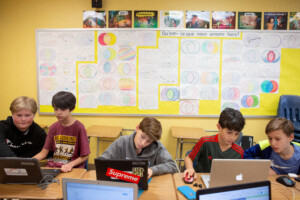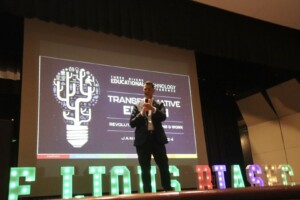Revolutionizing Teacher Professional Development

This post originally ran on the New Tech Network blog.
When I was hired to help open our school in 2006, I had no idea what I was getting in to. No clue. If I had known how grueling it was, I might have never agreed to take the job. Thankfully, I didn’t know, because even after having taught for eight years, I was as green as a celery stick.
How, one might ask, was I so green after nearly a decade of teaching? It was because I had never before been asked to be a part of developing a school culture from scratch. I was in for a true education.
The first warning sign that all of this was about to get real was that as the initial compulsory professional development was something called “Critical Friends” training. What, pray tell, was that? And what does it have to do with me and my ability to teach science and do PBL? And you’re telling me that I have to take a week out of my summer to do this?
What transpired over the coming months was the cultivation of something referred to as a “professional staff culture.” There were many parts of this process that were bizarre, almost surreal, in fact, for me as a young and previously isolated teacher. The first official act was to craft a set of “agreements” that would come to shape our interpersonal conduct and perhaps more importantly our attitudes about working with one another.
There were odd-sounding phrases like “If you wonder, ask” and “Listen and question for understanding” that were crafted using a million post-it notes that we all clustered all over a wall. In the end of the creation of this list of agreements there was a call for “consensus”, wherein we all had the opportunity to either agree that we supported the guidelines and would heretofore never sabotage them, or to disagree and offer alternative proposals. When consensus was called for, it was as if a covenant had been created. All of us had a voice in this. And it was good.
There were other bizarre things that happened. We all had to adapt to these new guidelines. On my very first New Tech school visits to Sacramento New Technology High School and New Technology High School, I had my first check-in with none other than my principal (one of agreements was that if someone ever said or did something specific that rubbed you wrong, you had 24 hours to either address the issue with a conversation or agree to let it go. This we called a “check-in.”) How did it go? I mean, a little bumpy. But I did it, and I know that we both benefited from it.
Little did I know in that year before our school opened that, before you can learn to function in a PBL classroom, you have to know how to function in the school that houses that classroom. I was embarking on something much larger than myself. There were many, many more bumps along the way. Some people had to leave. New people had to be brought on board and up to speed more quickly.
But here’s the best part: all of that forging of culture that happened during our school’s inception was not created with a sense of permanence. Instead, it was laid down as a bedrock (or, for you biology types, a layer of sediment.) When new people join our team, they are not simply taught our agreements. Instead, we review those agreements and seek fresh input. We actually repeat the whole post-it note process. What has resulted is an evolution of our agreements that fit our current environment, needs, and progress (see what I did there with the layers of sediment piece?)
One year when we had a particularly large influx of new staff members, we neglected to revise our agreements and instead simply presented them as “here they are.” What resulted was a divide. It was the Old Guys and the New Guys. We didn’t realize our error for a while, somehow. But eventually, out it came, just like it our agreements might predict that they would. It was a lesson we will never forget.
This part may or may not be obvious, but those agreements are not just for staff members. They are for the entire school community, from our administrators to students. We have to teach all of the members of that community what these agreements mean, how that translates into daily practice, and continually revise and evolve. Together. Naturally, we have to also get input on those agreements from students.
So here’s the revolution in professional development that I offer to the New Tech Network and New Tech Annual Conference (NTAC) 2016. Is it truly revolutionary? I don’t honestly know. I can’t speak for you, but for us, the two best things about NTAC are:
1) Being all together, and
2) Learning from our Network.
In that order. When the week is over, the people on your team are the people that matter the most.
1. Be a “No Tech New Tech” Staff. Log out of Echo. Put the curriculum maps and project planning forms away. I would say for the whole week, but that’s maybe not pragmatic, so for a whole day. Revisit or create your School Agreements. If need be, start over. Get all of your people in a room, with no technology other than pencils and post-it notes. Have everyone blast out all of the things that are held dearly and valued most with respect to your beliefs about professional school culture. Everyone do this, not just the new schools coming on board.
Affinity map those post-its and whittle it down to a manageable list of agreements that represent who you are now, this year and as a new group. Even if you have miraculously had no staff turnover, you are still not the same people you were a year ago. Take a fresh look at who you are now. When the list is in place, call for consensus. That means 100% All In. At the end of it, if you find yourself grinding your gears, delegate some of your literary types to “wordsmith” and come back with a polished set of proposed agreements. But before it’s considered done, get some student eyes on it (see below.) Give them a voice in your call for consensus.
2. Get your students on board. Now. Do it now. The Network has done many revolutionary things in recent years at NTAC with students as keynote speakers and panelists. It’s great. But you need to get your students in the loop. Who are your leaders? Identify them and get them on Skype with you, this week. Plan your school launch, your orientation event, and the structure of your student leadership with them, this week. If they need your mobile numbers, then so be it. If you still have hiring to do, get those students on your interview teams. There are no greater stakeholders for your work than your students, so get them in the loop, now.
3. Get out of your element. You’re already away from your families and school, so you have a great opportunity to have immersive experiences that will change the ways that you look at one another, forever. One of the best few hours we ever spent together was doing a team building challenge course at a retreat center with an outsider as our facilitator. It was uncomfortable in more ways than the humidity. Some of the other best few hours were at Mojo’s in Grand Rapids. As a rule, we always get in the river at NTAC, whatever the nearest one is. Go find a river.
The professional culture that we established through our New Tech has changed my life. In many ways my own experience has mirrored the outcomes that we look for in our students. I have learned to embrace responsible professional risks, in large part because that’s one of our agreements. In my prior life I was abjectly bad at public speaking. Last week I delivered the commencement address for our graduating class (and I did pretty well, I’d say.)
Writing has been a passion since fifth grade, and thanks to the encouragement of my peers, I do it now on a quasi- professional basis. My colleagues are so much more than that–they are some of my very best friends. It’s because we have been through a lot, and we’ve done it together, with a shared focus on culture. After all, the how is ultimately far more important than the what, don’t you think?
Here’s to hoping that you have an excellent week at NTAC 2016 and that the work that you do together has a lasting positive impact on your school culture. Have fun, and good luck!
For more, see:
- The Future of Professional Development is Collaborative Development
- The Future of Professional Learning: 4 Design Principles that Transform
- Five Ways Participants Get Value From Professional Learning MOOCs
Stay in-the-know with all things EdTech and innovations in learning by signing up to receive the weekly Smart Update. This post includes mentions of a Getting Smart partner. For a full list of partners, affiliate organizations and all other disclosures please see our Partner page.








0 Comments
Leave a Comment
Your email address will not be published. All fields are required.